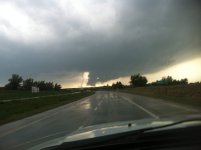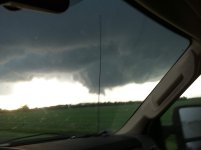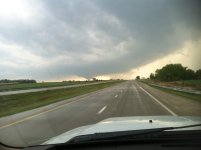There was an engineer's two story house in Norman completely blown away by a tornado (last year?). Nothing left but the slab. He had all the extra straps, extra bolts in the foundation, etc. None of it helped save the house.
They were all in the storm shelter and were ok.
All that extra bracing would have helped a lot in a near miss but doesn't mean squat when taking a direct hit from a biggun'.
I had a 16 ft pipe gate that opened one way (downhill) and would be very hard to open into the high side uphill. A gust of wind (probably microburst) blew it so hard the locking chain distorted the locking mechanism and the gate was blown open 90 degrees toward the uphill side. An all steel building with sturdy welded pipe frame had stood for over 40 years here in tornado alley. The straight wind folded in half a 14x14 foot door and blew it off its tracks and into the interior of the building. The door at the opposite end was also folded and blown out of the building. The doors had wind bracing. The new ones have twice the wind bracing.
Weirdest thing I ever knew about tornado wise was a town in Kansas that got slicked. A few folks left and the rest rallied and rebuilt residences and commercial structures and got slicked again, same date, next year. More folks left but some rebuilt and yup, you guessed it got slicked again next year same date. See myth #2 below.
Tornado Myths and Facts
There are many myths about tornadoes which are false and could be life threatening.
Myth #1:
When traveling by car...seek shelter under an overpass as a tornado approaches.
Fact:
Seeking shelter under an overpass is more dangerous than standing in an open field while a tornado is approaching. When a tornado passes over an overpass, winds are funneled under the bridge thereby increasing the velocity. The same phenomena can be experienced by standing between two buildings on a windy day. The best place to seek shelter while traveling is in a sturdy building. If no building is available, lie flat on the ground and cover your head or stay in your vehicle with seat belts fastened. Tornadoes do not follow terrain features exactly so chances are if the tornado comes directly toward your location...it will pass right over you. Be wary however...debris tends to collect in lows spots such as culverts and ditches...and flash flooding may be possible as well.
Myth #2:
Tornadoes never strike the same location twice.
Fact:
The town of Cordell Kansas had a tornado hit on May 20th three years in a row (1916...1917...1918). In Guy, Arkansas...three tornadoes hit the same church on the same day.
Myth #3:
Big cities and their tall buildings are protected from tornadoes.
Fact:
Big cities and their immediate surrounding areas are not protected from tornadoes. In fact...many cities across the United States have been hit directly within recent times such as Miami... Oklahoma City...Houston...Fort Worth...and Nashville. Even Salt Lake City has been directly hit. Utah only experiences a few tornadoes per year...but they can strike anywhere. Since big cities cover a relatively small geographical area...the chances of a tornado striking that particular area are relatively small...but not impossible. The myth that tall buildings protect cities from tornadoes is false since tornadic thunderstorms are typically 8 to 12 miles in height. A tall building of 500 to 1000 feet in height can not possibly deflect or destroy a tornado.
Myth #4:
Large lakes protect nearby areas from tornadoes.
Fact:
While cold water and the cool air on top of a large lake such as Lake Michigan can provide for a locally stable environment at times...chances are a thunderstorm producing a tornado moving toward a cold lake has a large driving force that can easily overcome the dampening effects of refrigerated air over a large lake.
In addition...typical lake breezes found along the Lake Michigan shore are often shallow and only affect a small portion of the lower atmosphere. Warm and unstable air above this marine layer/lake breeze could very well sustain thunderstorm strength. For example... on March 8, 2000...Milwaukee County experienced its earliest tornado on record at a time when Lake Michigan is climatologically coldest.
Myth #5:
Mountains...ridges...river valleys...and large lakes stop tornado development.
Fact:
Tornadoes are possible in every corner of the United States... including mountains...ridges...and river valleys. While conditions aren稚 optimal for tornado development on top of mountains or directly over lake Michigan...tornadoes have been documented to visit mountains at the 10 to 14 thousand foot level in the Sierra Nevada mountains and in Yellowstone National Park. Strong tornadoes have also been known to cross the Mississippi River and other large rivers or large lakes.
Myth #6:
Seeking shelter in the southwest corner of your house will protect you from being hit by debris...
Fact:
This myth was devised solely by the misconception that all tornadoes propagate in a northeast direction. Therefore as the tornado hits your house...all the debris will be brought with it to the northeast and away from you. Since tornadoes can move from any direction...this myth is obviously false. Debris such as pickup trucks and cars can also be shoved into the basement by a tornado. Obviously one can be crushed by a vehicle that is deposited into a basement. One should position themselves under the I-beam...a heavy work bench...or under the steps to increase their chances of survival. During a tornado warning...people will want to seek shelter in an interior room on the lowest level of the building...away from windows.
Myth #7:
To minimize damage to your house...open all the windows prior to a tornado striking it to equalize the pressure inside and prevent it from exploding...
Fact:
While tornadoes do have incredible pressure changes associated within them...if a tornado strikes your house directly...the winds and flying debris alone will damage it severely anyway. All homes have the ability to equalize their pressure inside...since no house is 100 percent air-tight.
Furthermore...by opening windows you allow no chance of the window shielding you from debris outside which may cause bodily harm...and it wastes precious time you need to take cover.
Myth #8:
Tornadoes only occur in the late spring and summer across Wisconsin...
Fact:
While the optimal time for tornado development occurs during May through august across Wisconsin...tornadoes may develop at any time of day and on any day of the year. Since 1950...tornadoes have been documented in the badger state during every month of the year.
Myth #9:
The shape and size of the tornado determines how strong it is...
Fact:
Tornadoes come in all shapes and sizes and one should not depend on how large they are or their shape to determine strength. The only way to determine the strength of the tornado is through damage assessments conducted by the national weather service...or by taking a direct measurement of wind. During damage assessments...National Weather Service employees look for clues that will tell them how strong the winds were. The wind estimate is then related to the enhanced-fujita tornado scale and a tornado intensity level will be assigned. Tornadoes are rated on a scale from ef0 to ef5...with ef5 being the strongest. Merely by looking at the tornado/s shape does not tell the whole story. The visible funnel is created by cloud condensation or dirt and debris. Conditions that create the visible funnel will change each time a tornado develops...and therefore one can not use this method reliably.
Myth #10:
Significant property or crop damage is always a result of a tornado...
Fact:
Tornadoes do produce significant damage. However straight-line down-burst winds can be just as destructive. Down-burst winds associated with severe thunderstorms are capable of reaching wind speeds of 100 to 150 mph...Or the equivalent of an ef1 or ef2 or ef3 tornado. Significant damage does not always imply a tornado. Several...less obvious...clues will tell National Weather Service employees whether a tornado or straight-line winds caused the damage.
Myth #11:
Mobile homes attract tornadoes...
Fact:
Nothing attracts tornadoes. Tornadoes form and travel at their own leisure. It seems as though mobile homes attract tornadoes because they are more susceptible to damage. However...on a pro- rated basis...higher numbers of fatalities and injuries occur with mobile-trailer homes.
Myth #12:
The number of tornadoes per year has been increasing due to more favorable weather conditions.
Fact:
The number of documented tornadoes in the U.S. has increased since the early 1900s. However...this increase is mostly likely due to the general increase in the population...more trained storm spotters...better radar detection technology...and better follow-up damage surveys. Tornadoes have not become more common due to more favorable weather conditions.
I'm not superstitious but I think after twice I would have taken a hint.



